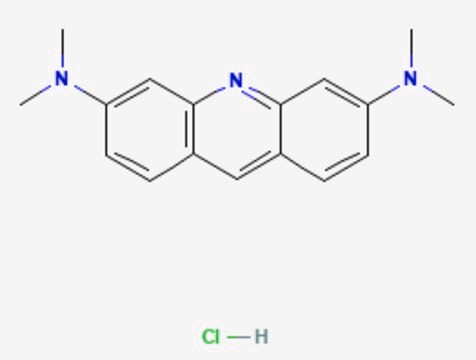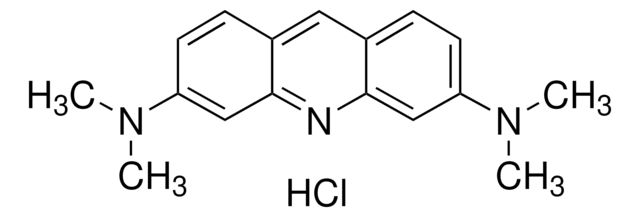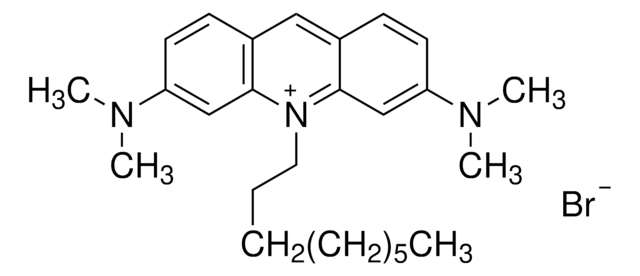Key Documents
235474
Acridine Orange base
Dye content 75 %
Synonim(y):
3,6-Bis(dimethylamino)acridine, Solvent Orange 15
About This Item
Polecane produkty
Postać
powder
Poziom jakości
skład
Dye content, 75%
mp
165 °C (dec.) (lit.)
rozpuszczalność
1 M HCl: 1 mg/mL, clear
λmaks.
488 nm
ε (współczynnik ekstynkcji)
≥14000 at 227-233 nm
≥20000 at 289-295 nm
≥35000 at 486-492 nm
≥40000 at 266-272 nm
Zastosowanie
diagnostic assay manufacturing
hematology
histology
temp. przechowywania
room temp
ciąg SMILES
CN(C)c1ccc2cc3ccc(cc3nc2c1)N(C)C
InChI
1S/C17H19N3/c1-19(2)14-7-5-12-9-13-6-8-15(20(3)4)11-17(13)18-16(12)10-14/h5-11H,1-4H3
Klucz InChI
DPKHZNPWBDQZCN-UHFFFAOYSA-N
Szukasz podobnych produktów? Odwiedź Przewodnik dotyczący porównywania produktów
Opis ogólny
Zastosowanie
Kod klasy składowania
11 - Combustible Solids
Klasa zagrożenia wodnego (WGK)
WGK 3
Temperatura zapłonu (°F)
Not applicable
Temperatura zapłonu (°C)
Not applicable
Środki ochrony indywidualnej
Eyeshields, Gloves, type N95 (US)
Wybierz jedną z najnowszych wersji:
Masz już ten produkt?
Dokumenty związane z niedawno zakupionymi produktami zostały zamieszczone w Bibliotece dokumentów.
Klienci oglądali również te produkty
Nasz zespół naukowców ma doświadczenie we wszystkich obszarach badań, w tym w naukach przyrodniczych, materiałoznawstwie, syntezie chemicznej, chromatografii, analityce i wielu innych dziedzinach.
Skontaktuj się z zespołem ds. pomocy technicznej








